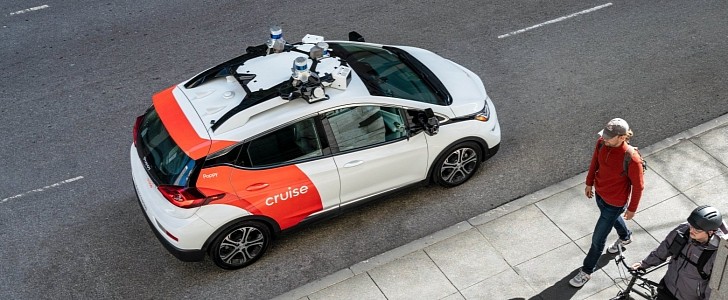On June 3, one Cruise robotaxi operating in San Francisco without a driver on board was involved in a crash with another vehicle during an unprotected left turn. After analyzing the crash data, GM recalled and updated the autonomous driving system (ADS) software.
The crash on June 3 reveals what might happen when an autonomous driving vehicle has to deal with human driving inconsistencies in a real-world scenario. According to the crash data and police investigation, the other driver was to blame, traveling well above the speed limit in the wrong (right turn only) lane. Based on the lane it was traveling in, the Cruise software incorrectly predicted its path, initiating the unprotected left turn.
When the other driver saw the Cruise vehicle turning, they suddenly changed lanes and proceeded straight through the intersection. This was probably intended to avoid the Cruise vehicle. Had the Cruise robotaxi continued on its path, nothing would likely have happened. Unfortunately, the Cruise’s ADS software braked hard, which left the robotaxi car in the way of the speeding vehicle. But these are all speculations, and the hard facts show that the speeding driver was to blame, according to the police report.
Right after the crash, Cruise responded with mitigation measures, including disabling unprotected left turns. Later, Cruise decided that the software governing its autonomous driving system could’ve made a better decision. According to the public filings, the recalled software may “incorrectly predict another vehicle’s path or be insufficiently reactive to the sudden path change of a road user.”
This prompted a recall and a software update on all 80 vehicles in its fleet. The new update should allow Cruise vehicles to predict other vehicles’ paths better in various situations, including conditions similar to the one that led to the San Francisco crash.
According to a crash report from the California DMV, two people were injured when the Cruise vehicle collided with a Toyota Prius on June 3. Occupants in both vehicles received medical treatment for “alleged minor injuries.” The crash made the news because it happened just one day after Cruise received the permit to carry paying riders without a driver present in the car. It was the first company to obtain such a permit in the state.
When the other driver saw the Cruise vehicle turning, they suddenly changed lanes and proceeded straight through the intersection. This was probably intended to avoid the Cruise vehicle. Had the Cruise robotaxi continued on its path, nothing would likely have happened. Unfortunately, the Cruise’s ADS software braked hard, which left the robotaxi car in the way of the speeding vehicle. But these are all speculations, and the hard facts show that the speeding driver was to blame, according to the police report.
Right after the crash, Cruise responded with mitigation measures, including disabling unprotected left turns. Later, Cruise decided that the software governing its autonomous driving system could’ve made a better decision. According to the public filings, the recalled software may “incorrectly predict another vehicle’s path or be insufficiently reactive to the sudden path change of a road user.”
This prompted a recall and a software update on all 80 vehicles in its fleet. The new update should allow Cruise vehicles to predict other vehicles’ paths better in various situations, including conditions similar to the one that led to the San Francisco crash.
According to a crash report from the California DMV, two people were injured when the Cruise vehicle collided with a Toyota Prius on June 3. Occupants in both vehicles received medical treatment for “alleged minor injuries.” The crash made the news because it happened just one day after Cruise received the permit to carry paying riders without a driver present in the car. It was the first company to obtain such a permit in the state.







